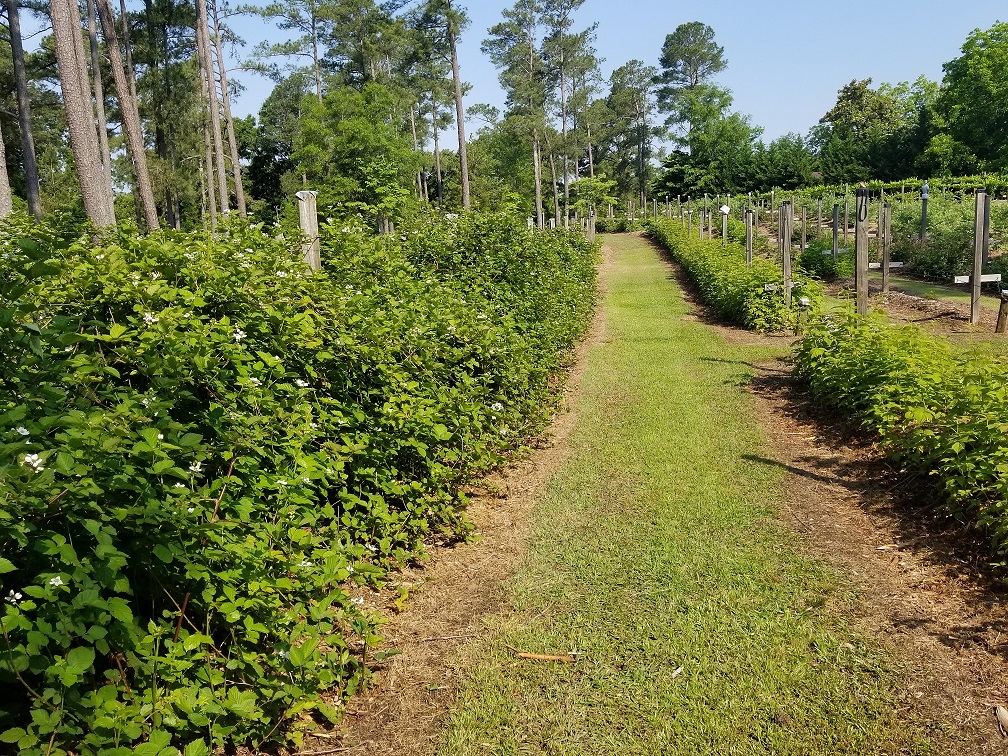
ABOUT BLACKBERRIES:Rubus spp.
ROSACEAE
Relatives: Pacific Dewberry
Blackberry vines tend to have one of two distinct growth patterns: one group is fairly upright and doesn't necessarily need something like a trellis to grow on, and the other group tends to trail on the ground and does need a trellis for support. Blackberries can be found on every continent in the world except Antarctica. They probably started (who knows for sure) in North or South America, Europe, and/or Asia. What we do know for sure is that they are everywhere in the wilds and under cultivation.
DESCRIPTION
Vines, as mentioned above, tend to be either upright or falling down. Many of the wild Blackberries are heavy with thorns and are a pain to pick, but some smart soul kept at it until he developed a thornless variety for which we (and probably you) are grateful!
Leaves: Deciduous and compound, they aren't much to look at; serrations on the margins of the leaves. Some cultivars have small thorns on the leaves.
Flowers: White to pink, rather smallish but seldom fragrant. Pollination is by bees and insects, although there are several self-fertile varieties available. I imagine the wind would also help pollinate.
Fruit: Blackberries are an aggregate fruit, with each individual 'berry' containing numerous druplets (tiny individual berries) which all grow from a single flower and ripen at the same time. The fruits range in color from a deep purple to a black black.
CULTIVATION
Blackberries are very easy to grow and are especially well suited for the beginning small fruit gardener. They are most forgiving of soil types but not so tolerant of maritime conditions or very windy areas.
Location: They grow best in full sun and will benefit from constant moisture, particularly as they begin fruit set.
Temperature: Blackberries grow best in warm areas but can actually survive freezing temperatures. Late season frosts do not seem to overly hurt the flowering and berry production.
Chilling: Chilling refers to the number of hours, 45 degrees F and under, during the dormancy period. All fruit and nut trees need a specific amount of chilling hours before they will produce fruit. The amount varies with each variety and the hours need not be continuous. For example as listed: (500 hours).
Soil/water/nutrients: Blackberries grow best in deep, well drained, loamy soils, although they are remarkably tolerant of even sandy and clay soils. They are not deeply rooted, so a layer of mulch will help keep the roots from overheating in the summer. Not a big nutrient hog, Blackberries nonetheless will benefit from a twice yearly addition of nutrients in the spring and again in late summer. Any balanced fertilizer such as 8-8-8 or 10-10-10 would be fine.
Pruning: Don't expect any fruit the first year- instead prune back the canes to three or four of the strongest ones per plant. The canes will fruit and then die back during their second year and that cycle will continue on in future years. These can be removed either after fruiting or in the winter, being sure you are only removing the second year canes (the canes that are dead).
Pests and diseases: Blackberries are fairly disease and pest free, but there are some things to keep your eyes on: there are several fungal diseases that can attack both the leaves and the canes, and anthracnose can cause fruit loss. Prune out any diseased canes and burn, if possible. There are some beetles that will target the canes, but the home gardener does not need to be overly concerned. The Spotted Wing Drosophila (a small fruit fly which targets blackberries, raspberries, and blueberries) has begun spreading throughout NC in the past few years. You can tell if they are present because the blackberries will begin to rot before they are fully ripe, or 1-2 days of being picked. You can use Malathion or the organic chemical Spinosad (applied weekly to the ripening berries) to control SWD.
CULTIVARS
There are several Heirloom Blackberry cultivars as well as some hybrid Blackberry varieties that you can chose from. All Blackberries that we sell are self fertile and do not require another Blackberry for a Pollinator. Rabbit Ridge Nursery currently offers the following cultivars, which will do quite nicely in our area:
Upright means that it can grow without a trellis but can be trellised for more control and a neater appearance
Semi-Upright means that is needs a trellis to grow and fruit properly
(Click on Blackberry Variety to link to that Blackberry)
- Thornless Blackberry 'Apache' ®
- Thornless Blackberry 'Heaven Can Wait'®
- Thornless Blackberry 'Prime-Ark Traveler'®
- Thornless Blackberry 'Triple Crown'
- Blackberry Hybrid 'Boysenberry'
- Blackberry Hybrid 'Logan'
- Blackberry Hybrid 'Snowbank'®
- Blackberry Hybrid 'Tayberry '
Blackberries are the highest in antioxidants of small berry fruits.....followed by Raspberries and then Blueberries.